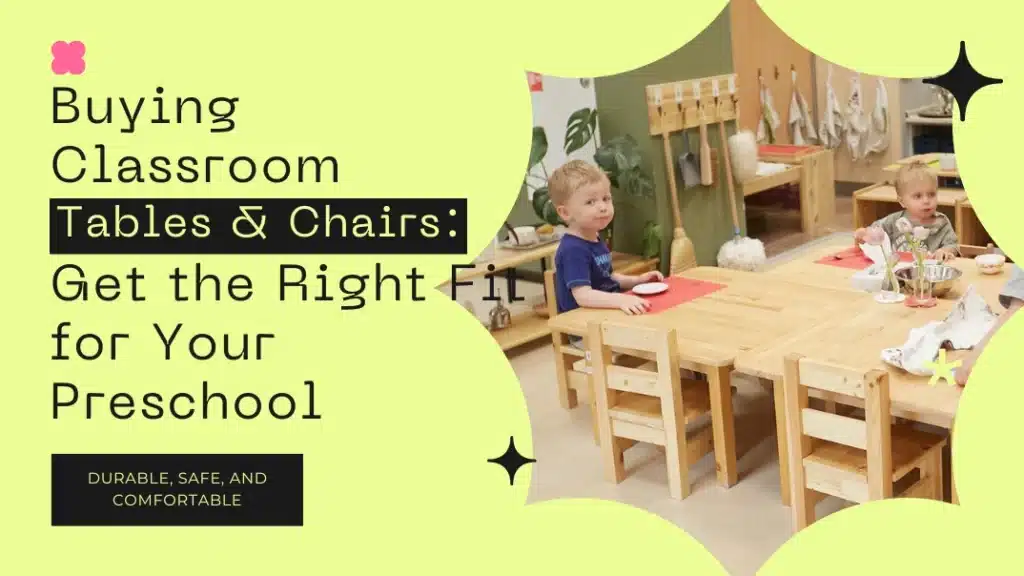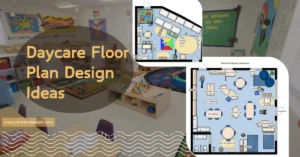When setting up a preschool classroom, selecting suitable classroom tables and chairs is more crucial than we might initially think. Classroom tables and chairs are not just places for children to sit and learn—they directly impact a child’s comfort, learning efficiency, and lth. If the height of the tables and chairs is not appropriate, children may feel uncomfortable during class, which, over time, can lead to poor posture or other health issues. Choosing tables and chairs with the correct height for any preschool is foundational to creating a safe and effective learning environment.
To get the best fit for your preschool, it’s essential to select classroom tables and chairs that meet the ergonomic needs of children. This involves considering factors like adjustable height, table shape, and material quality. Properly chosen furniture can significantly enhance the classroom experience, contributing to better posture and concentration.
It’s important to emphasize that finding the right fit for your preschool’s classroom tables and chairs is essential to meeting the ergonomic needs of children. Every child is unique, and so are their height and sitting posture, making the height of the tables and chairs, the shape of the table surfaces, and the choice of materials all critical considerations. When carefully addressed, classroom tables and chairs can significantly enhance the overall classroom experience, helping children focus on tasks while maintaining good posture.
We all know that preschoolers spend a significant amount of time in the classroom each day, so the tables and chairs they use must provide ample support and comfort. Suitable tables and chairs help children maintain proper sitting posture and minimize distractions caused by physical discomfort during their studies. We must pay close attention to every detail when selecting classroom tables and chairs, ensuring our children learn in a healthy and comfortable environment.
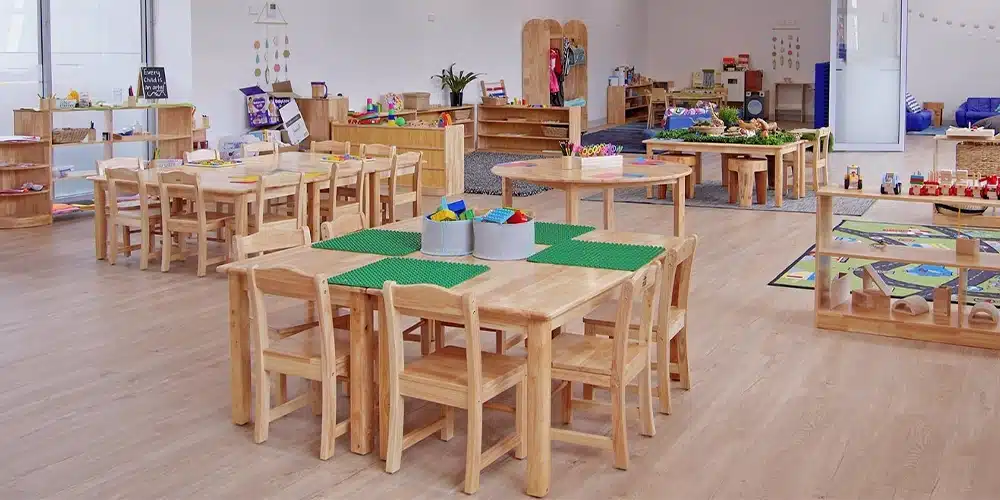
Why Is It Important to Choose the Right Classroom Table and Chair Height?
Choosing the correct height for classroom tables and chairs is not just about ensuring comfort for children—it’s about protecting their overall health and well-being. Imagine a child who spends several hours each day sitting on a chair that’s too high or too low. Over time, this can lead to serious posture problems, such as slouching or hunching over the table, which can cause back, neck, and shoulder pain. This discomfort doesn’t just affect their health and can make it difficult for them to focus on their lessons, as their mind might be distracted by physical pain.
Properly sized classroom tables and chairs allow children to sit with their feet flat on the floor and their knees at a 90-degree angle. This positioning is critical because it helps maintain the spine’s natural curve, reducing strain on the lower back. When children are seated correctly, their hands rest comfortably on the table, allowing them to write, draw, and engage in activities without awkward stretching or bending. This alignment promotes better concentration, as the child isn’t constantly adjusting themselves to find a more comfortable position.
In addition to comfort, ergonomics is crucial in classroom furniture design. When we talk about ergonomics, we’re referring to how well the furniture supports the natural movements and posture of the body. This support is even more critical for children whose bones and muscles are still developing. Ergonomically designed classroom tables and chairs encourage proper posture from an early age, helping to prevent the development of bad habits that could lead to chronic pain or discomfort later in life.
Furthermore, correctly sized classroom tables and chairs create a more inclusive and engaging learning environment. Children comfortable in their seats are likelier to participate actively in classroom activities. They can focus on their tasks without the distraction of discomfort, leading to better academic outcomes and a more positive attitude toward school. In contrast, poorly sized furniture can cause children to fidget, become restless, and lose interest in their work, disrupting the classroom dynamic.
Selecting suitable classroom tables and chairs demonstrates a commitment to the student’s well-being. It shows that we, as educators and providers, care about creating a learning environment that supports their academic growth and physical health. This attention to detail can build trust with parents, who want to know that their children are being cared for in every aspect while at school.
Finally, it’s important to remember that the needs of children can change as they grow. What fits a three-year-old perfectly may not be suitable for a five-year-old. This is why adjustable classroom tables and chairs can be an excellent investment. They allow for easy modifications as children grow, ensuring the furniture remains comfortable and supportive. This adaptability saves money in the long run and ensures that the classroom remains a healthy place for learning at every stage of a child’s development.
Choosing the right height for classroom tables and chairs is more than just comfort—supporting our students’ health, focus, and overall well-being. By ensuring that the furniture is ergonomically designed and adequately sized, we can create a learning environment where children feel comfortable, engaged, and ready to learn daily.
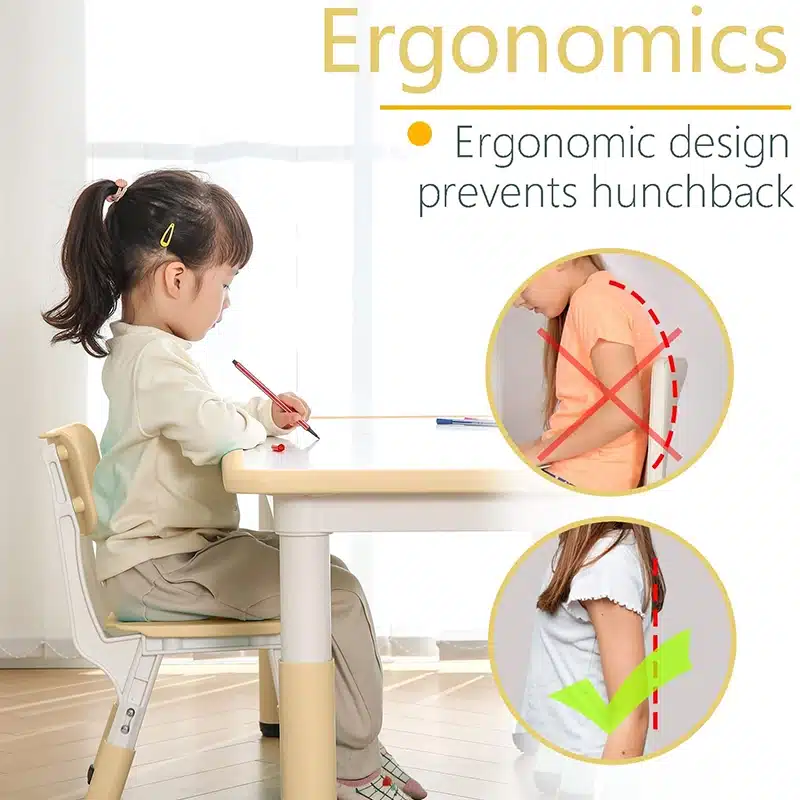


Tips to Choose the Right Classroom Table and Chair Height
Selecting suitable classroom tables and chairs is a critical task that requires considering multiple factors carefully. Each classroom is unique; the furniture must complement the students’ physical needs, and envies dive deeper into the key aspects you should consider to ensure that the tables and chairs in your classroom are ideally suited for your students.
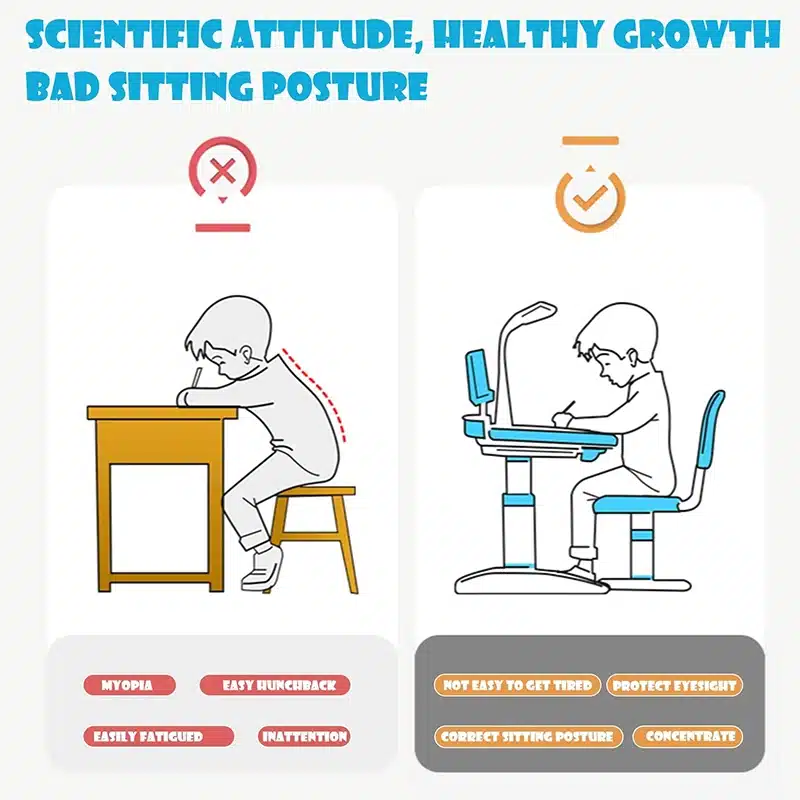
Understand Ergonomics: Before making any decisions, it’s essential to grasp the importance of ergonomics in the classroom. Ergonomics is all about designing furniture that fits the human body, reducing strain and increasing comfort. For young children, classroom tables and chairs should allow them to sit with their feet flat on the floor, their knees bent at a 90-degree angle, and their arms comfortably resting on the table. Children sitting in such a position are more likely to maintain good posture, which is crucial for their developing bodies. Proper ergonomics in classroom furniture can help prevent long-term health issues and ensure students can focus on their learning rather than discomfort.
Measure Students’ Height: One of the most straightforward ways to choose suitable classroom tables and chairs is by measuring the height of your students. These measurements will guide you in selecting furniture that allows each child to sit comfortably. For example, a general rule is that the chair should be approximately one-third of the child’s height. This ensures that when the child sits, their feet are firmly on the ground and their knees are at the correct angle. It’s also important to remember that children increase, so you may need to reassess and adjust the furniture periodically to accommodate their changing sizes.
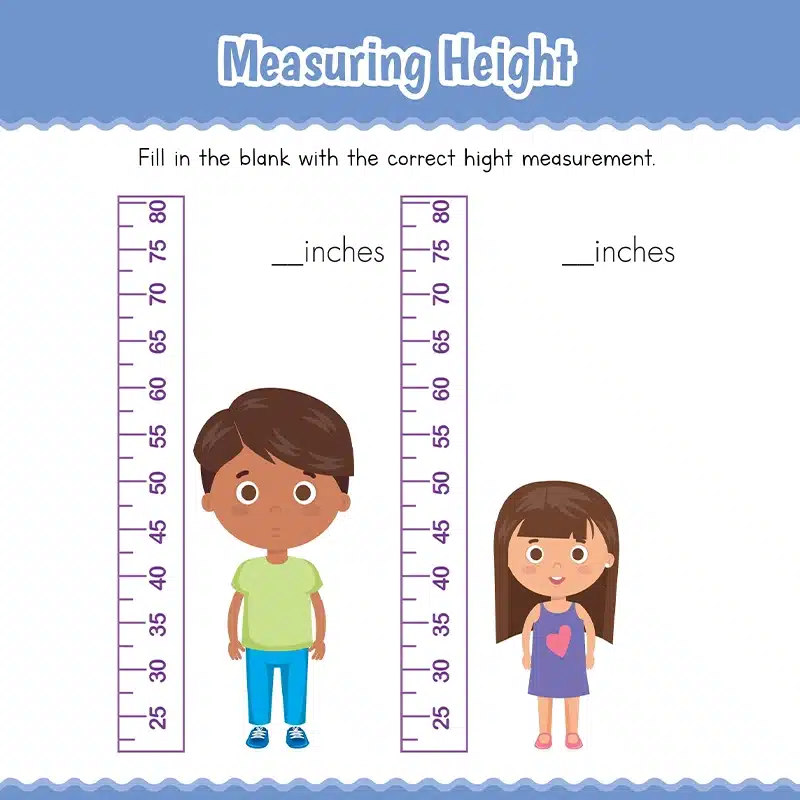
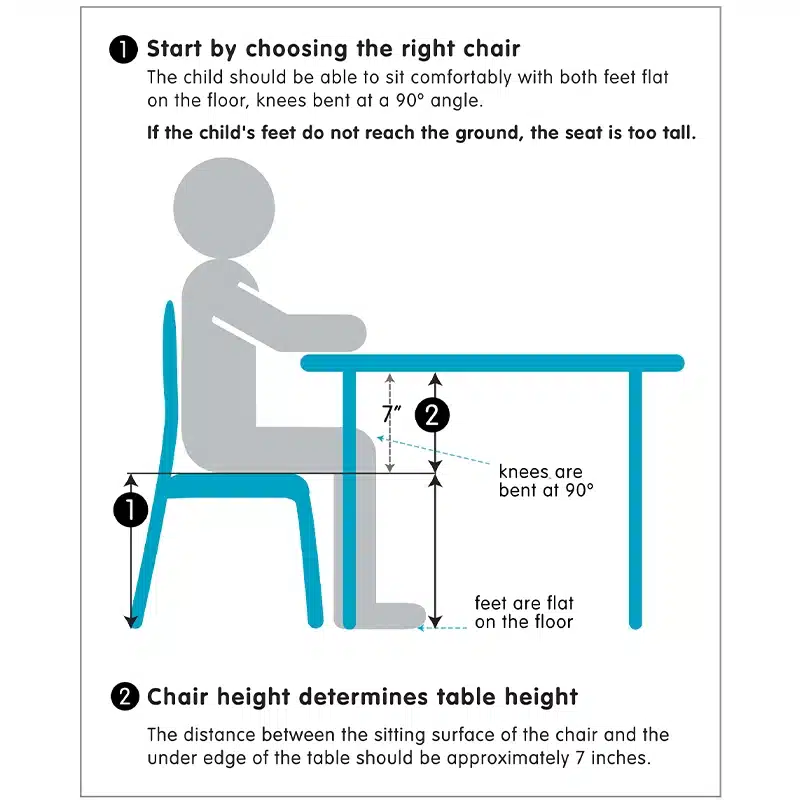
Follow the 90-90-90 Rule: The 90-90-90 rule is a simple guideline that can help you quickly assess whether a chair and table are the right height. This rule states that the child’s knees, hips, and elbows should all be at 90-degree angles when seated. This position supports the spine’s natural alignment and reduces the risk of discomfort or injury. Using this rule as a benchmark, you can quickly determine if the classroom tables and chairs are suitable or if adjustments need to be made.
Choose Adjustable Furniture: Investing in adjustable classroom tables and chairs is wise, especially in a preschool setting where children constantly grow. Adjustable furniture allows you to modify the height of the tables and chairs, ensuring they remain comfortable and ergonomically appropriate for students as they grow. This flexibility is precious in classrooms with mixed-age groups, where students of different sizes may need different heights. Adjustable tables and chairs also provide long-term cost savings, as they can be used for several years without needing replacement.

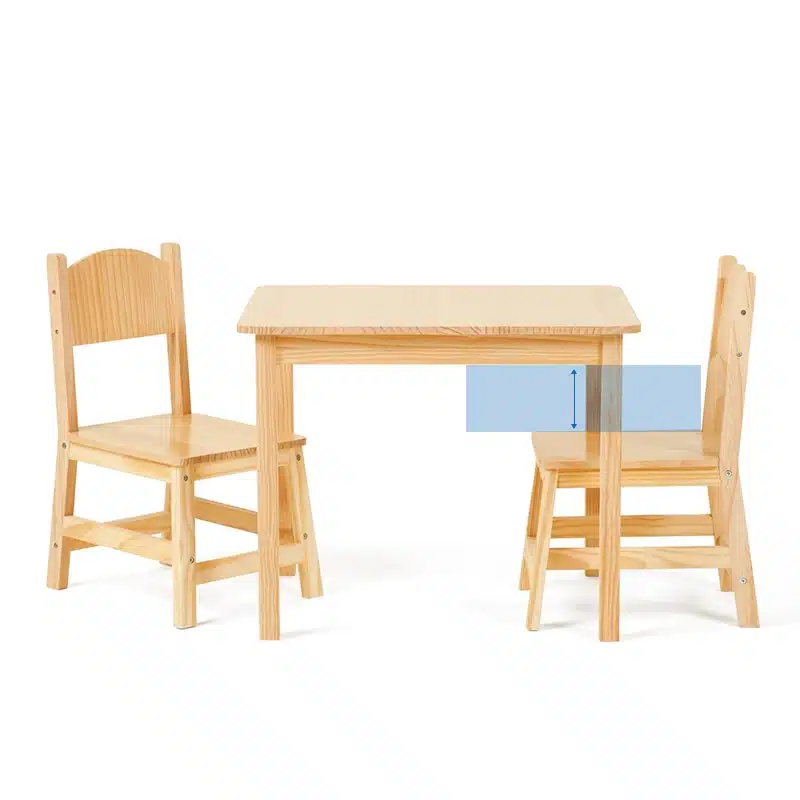
Check for Clearance: Clearance refers to the space between the table’s underside and the chair’s seat. Ensuring enough clearance for students to sit comfortably without feeling cramped is essential. Too little space can force children to hunch over, leading to poor posture and discomfort. Ideally, students should have sufficient room to slide their chairs in and out quickly and move their legs without restriction. This freedom of movement is critical to maintaining a comfortable and dynamic learning environment.
Consider the Space Between the Chair and Table: When arranging classroom tables and chairs, it’s essential to think about the spacing between them. There should be enough space for students to sit with their legs comfortably under the table without feeling too cramped, but not so much space that they have to stretch or lean forward awkwardly to reach their work. Proper spacing helps students maintain good posture and reduces the likelihood of fidgeting or becoming restless during lessons. Additionally, this space allows for smooth transitions in and out of seats, which is essential for maintaining an organized and efficient classroom flow.
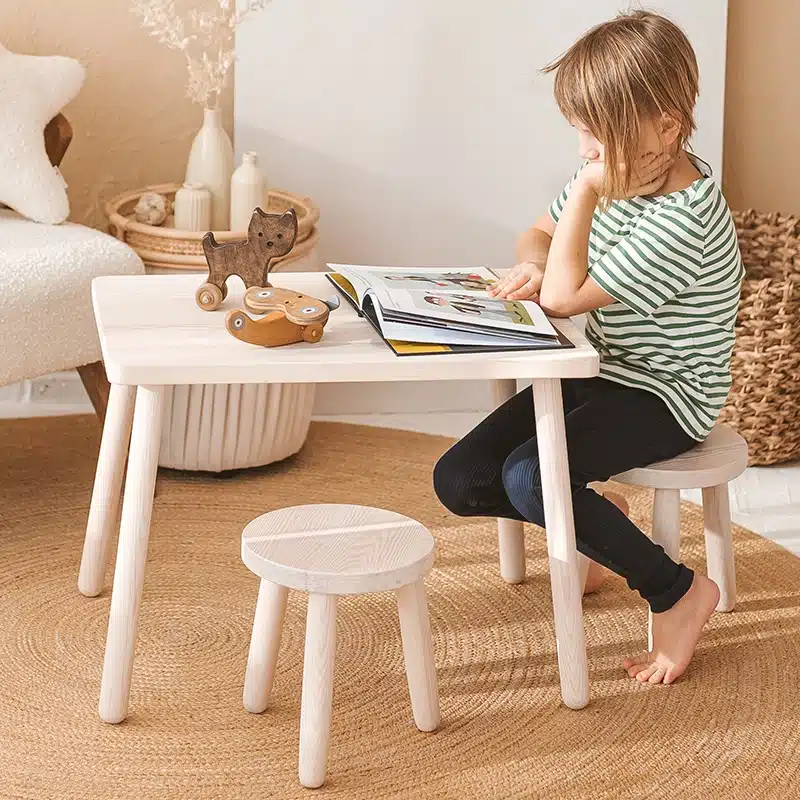

Select Appropriate Chair and Table Materials: The materials used in classroom tables and chairs are just as necessary as their height and design. Look for materials that are durable, easy to clean, and safe for children. For example, wood is famous for its sturdiness and natural appearance, but plastic can also be a great option due to its lightweight nature and ease of maintenance. Whichever material you choose, ensure the surfaces are smooth and the edges are rounded to prevent injuries. Safety should always be a top priority when selecting classroom furniture.
Mind the Shape and Size of Tables: Classroom tables come in various shapes and sizes, each with advantages depending on your classroom layout and the activities you plan to conduct. Rectangular tables are versatile and can be arranged in rows or clusters to facilitate different teaching methods. Round tables are excellent for group work and discussions, as they encourage student interaction and collaboration. Square tables offer a compact solution for smaller spaces. When selecting tables, consider how they will fit into your classroom and whether they will support the learning environment you want to create.
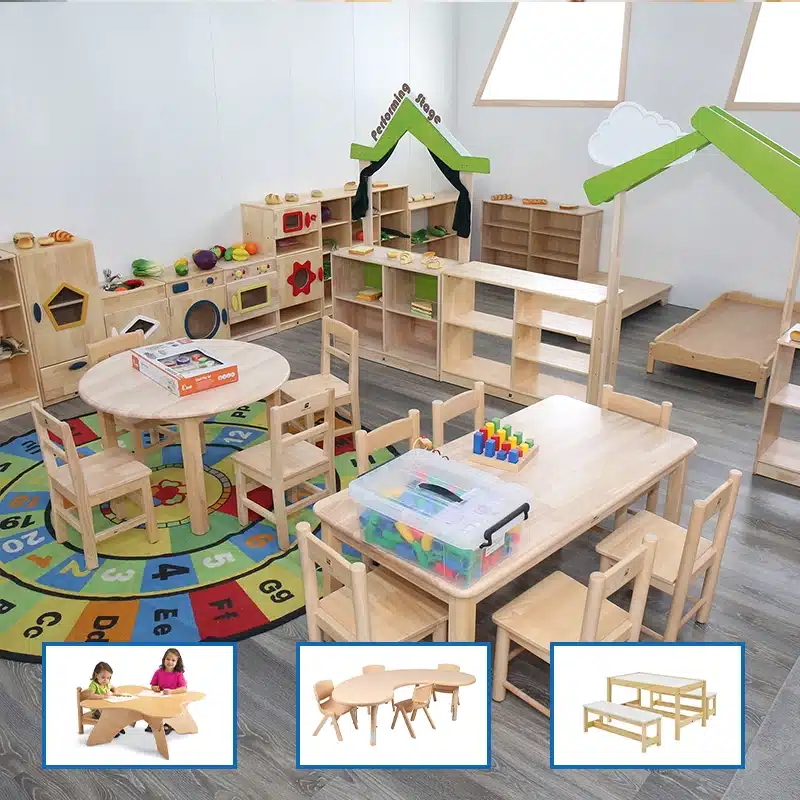
By carefully considering these factors, you can ensure that the classroom tables and chairs you select will meet the needs of your students and create a supportive and engaging learning environment.
What Are the Benefits of Adjustable Height Classroom Furniture?
Adjustable height classroom furniture offers a range of benefits that make it an excellent choice for any preschool setting. One of the most significant advantages is its flexibility. With adjustable tables and chairs, you can easily modify the height of the furniture to fit children of various ages and sizes. This means that the same classroom tables and chairs can be used year after year, even as the children grow. This adaptability is particularly valuable in mixed-age classrooms, where students of different heights and developmental stages share the same space. Instead of buying new furniture each time your student population changes, you can adjust the height of the existing pieces to meet everyone’s needs.
In addition to flexibility, adjustable classroom tables and chairs help maintain proper ergonomics as children grow. As students get taller, their furniture must grow to support their developing bodies. Ergonomics is about creating a comfortable and safe environment supporting natural movements. When the furniture is adjusted to the correct height, it allows students to sit with their feet flat on the floor, their knees at a 90-degree angle, and their arms resting comfortably on the table. This positioning is essential for preventing strain on their muscles and joints, which can lead to discomfort or even long-term health problems. Adjustable furniture helps reduce the risk of musculoskeletal issues by maintaining ergonomic standards, ensuring that students remain comfortable and focused throughout the school day.

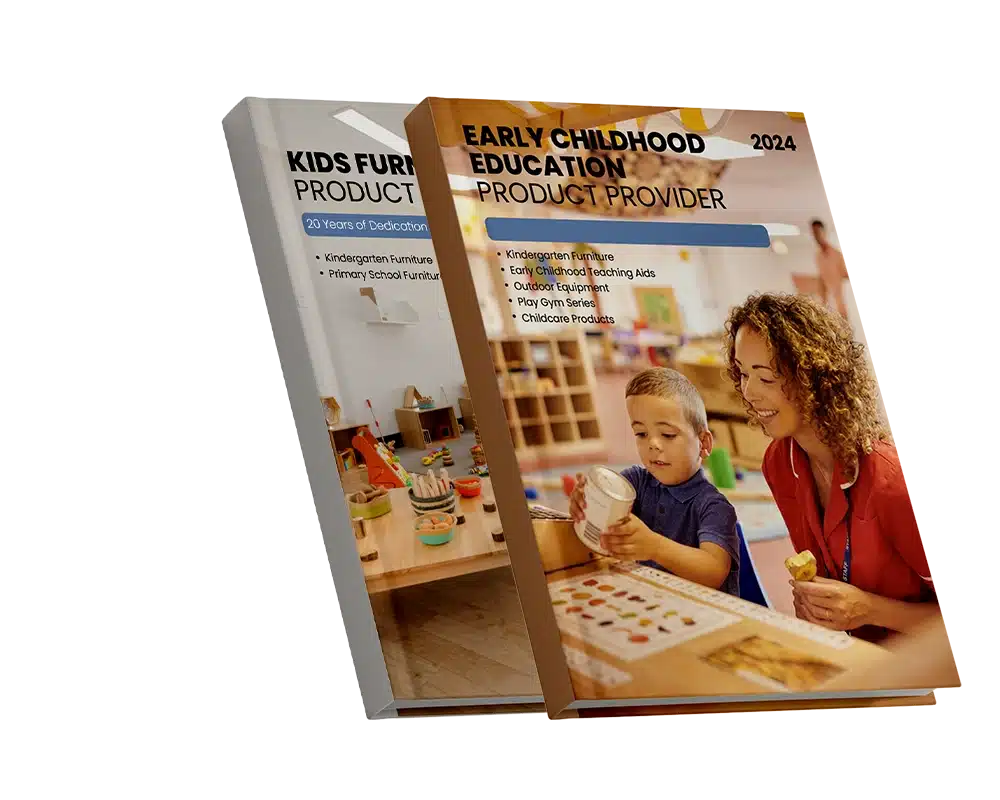
Another essential benefit of adjustable-height classroom furniture is that it can contribute to a more inclusive learning environment. Children grow at different rates, and in a traditional classroom, this can sometimes lead to issues where one child’s furniture fits perfectly while another’s is either too small or too large. Adjustable tables and chairs eliminate this problem by allowing each piece of furniture to be tailored to the child’s needs. This ensures that every student, regardless of their size, has a seat that fits them well, helping to boost their confidence and engagement in classroom activities.
Moreover, using adjustable furniture can lead to cost savings for schools. Instead of purchasing new sets of classroom tables and chairs as students advance in age and size, schools can make a one-time investment in adjustable furniture that will serve their needs for many years. This reduces the need for frequent furniture replacements and minimizes the logistical challenges of constantly updating classroom setups. Schools can allocate their resources more effectively, focusing on other areas that can enhance the educational experience.
Finally, adjustable-height furniture is also beneficial from a design perspective. It allows for greater flexibility in classroom arrangements, as tables and chairs can be adapted to fit different teaching styles and activities. For example, tables can be lowered for younger children engaged in hands-on activities or raised for older students working on more advanced projects. This versatility makes it easier to create a dynamic learning environment that can evolve with the changing needs of the students and the curriculum.
What Are Some Guidelines for Choosing Table and Chair Heights for Different Age Groups?
When selecting classroom tables and chairs, choosing the correct height is essential to ensure each child can sit comfortably and maintain good posture throughout the day. Here are some general guidelines for selecting the appropriate heights for different age groups:
- For Ages 3-5: At this young age, children are just beginning to develop their fine motor skills and are typically shorter in stature. The chair height should range from 10 to 12 inches for these students, while the table height should be between 20 to 22 inches. These dimensions provide a comfortable fit, allowing the children to sit with their feet flat on the floor and their arms resting easily on the table surface.
- For Ages 6-8: Their furniture needs to grow with them as children grow. The chair height should be adjusted to 12 to 14 inches for students in this age group, with table heights ranging from 22 to 24 inches. This size accommodates the children’s increased height while maintaining the ergonomic principles necessary for good posture and comfort.
- For Ages 9-12: Older children require more oversized furniture to match their growth. For this age group, the chair height should be between 14 to 16 inches, and the table height should be adjusted to between 24 to 26 inches. These dimensions ensure that the students can sit comfortably with their knees at a 90-degree angle and their arms positioned correctly for writing and other activities.
While these guidelines provide a helpful starting point, it’s important to remember that every child is unique. Some may be taller or shorter than average for their age group, so it’s essential to consider the specific heights and needs of the children in your classroom when selecting furniture. In some cases, adjustable classroom tables and chairs may be the best solution, as they allow for fine-tuning to ensure each student has a perfect fit. This personalized approach helps create a more comfortable and supportive learning environment where all students can thrive.

Other Aspects About Classroom Furniture to Consider
When choosing classroom tables and chairs, looking beyond the height and size is essential. While these factors are crucial, other elements also play a significant role in creating a comfortable, safe, and effective learning environment for young children. Let’s explore some additional aspects you should consider to ensure that the classroom furniture you select meets all your needs.
- Material: The material of the classroom tables and chairs is a critical factor that affects durability, safety, and ease of maintenance. Classroom furniture should be made from sturdy, non-toxic materials that can withstand the wear and tear of daily use by energetic children. Wooden tables and chairs are popular because of their durability and natural aesthetic appeal. They provide a warm, inviting look that fits well in most classroom settings. However, plastic furniture is also an excellent option, especially for younger children. Plastic tables and chairs are lightweight, making them easier to move around and rearrange and clean. When choosing the material, consider the specific needs of your classroom—whether you need furniture that can handle heavy use or something more accessible to sanitize regularly.
- Color: The color of classroom tables and chairs can significantly impact the learning environment. Bright, cheerful colors can stimulate a child’s mind, encouraging creativity and making the classroom a more inviting place to learn. For example, a mix of colors can help define different classroom areas, such as a reading corner or an arts and crafts station. However, it’s essential to strike a balance—while bright colors are engaging, they should not be so overwhelming that they become distracting. Neutral or pastel colors can provide a calming effect and are often a good choice for creating a peaceful learning atmosphere. Consider how the colors of the furniture will blend with the rest of the classroom decor, ensuring a harmonious and visually appealing space.
- Function: Beyond their primary use, some classroom tables and chairs offer additional features that can enhance functionality. For instance, some tables come with built-in storage compartments, which can be incredibly useful for keeping classroom supplies organized and within easy reach for teachers and students. Foldable tables and chairs are another practical option, offering classroom flexibility that may need reconfiguring for different activities or creating more space when not in use. Consider the specific needs of your classroom—if you often need to store items or change the room layout, multifunctional furniture could be the perfect solution. The goal is to select classroom tables and chairs that provide a place for children to sit and contribute to the overall efficiency and organization of the space.
- Design: The design of classroom tables and chairs should prioritize the safety and comfort of young children. Child-friendly design features include rounded edges to prevent injuries, stable legs to avoid tipping, and the right proportions to support proper posture. Additionally, consider the overall aesthetic of the classroom. Functional and visually appealing furniture can create a more cohesive and inviting learning environment. For example, tables with adjustable legs or chairs with a stackable design can be both practical and stylish. The design should also reflect the classroom’s educational goals—whether it’s fostering collaboration through group tables or providing individual workspaces with separate desks. The right design can significantly affect how students interact with their environment and each other.
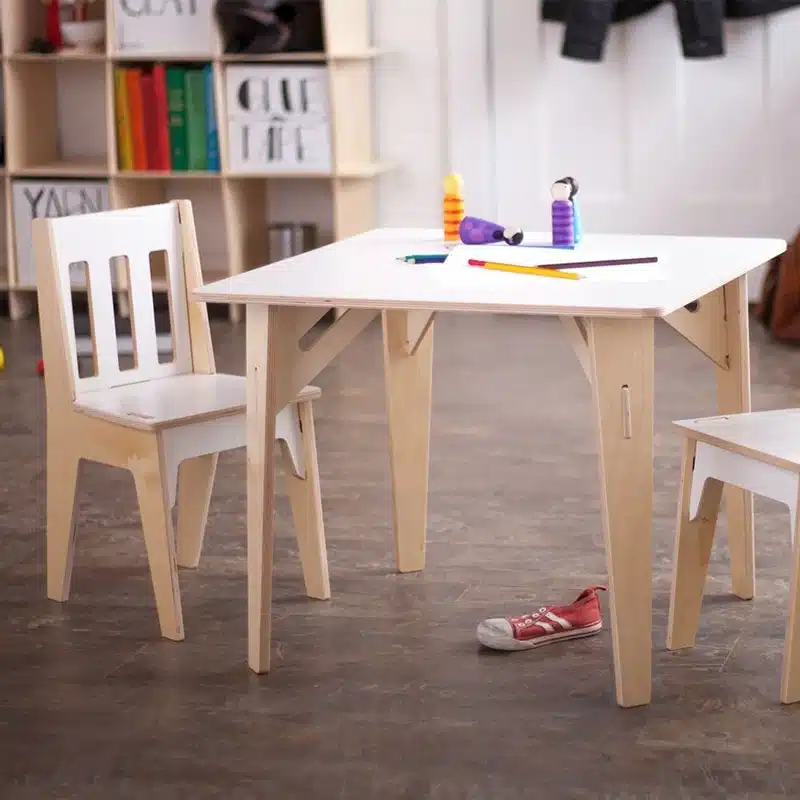


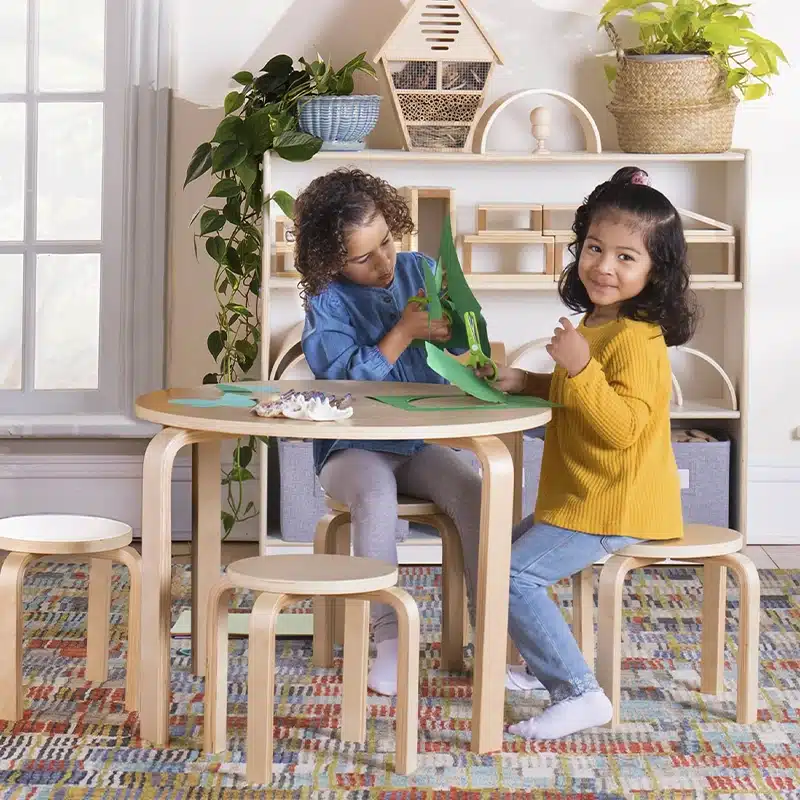
Why Choose Us?
At Xiha Montessori, choosing suitable classroom tables and chairs is vital to setting up a thriving learning environment. We understand that each classroom has unique needs, so we offer a range of high-quality, customizable options that can be tailored to fit your specific requirements. Our tables and chairs are crafted with care, using the best materials to ensure they are durable, safe, and suitable for young learners. We believe classroom furniture should do more than provide a place to sit—it should support the overall educational experience by promoting comfort, safety, and a positive atmosphere.
Our customer service team is dedicated to helping you find the perfect furniture solutions for your preschool. Whether you need advice on selecting the correct sizes, colors, or materials or looking for furniture that can adapt to different classroom activities, we’re here to assist you every step. We take pride in our attention to detail and commitment to quality, ensuring that the furniture you choose meets and exceeds your expectations.
In summary, choosing suitable classroom tables and chairs is a critical decision that affects your students’ well-being and learning experience. With the right furniture, you can create a nurturing, comfortable, and practical educational space where children can thrive. At Xiha Montessori, we’re here to help you make that happen, offering top-notch products and exceptional service to support your preschool’s success.
Selecting suitable classroom tables and chairs is not just a matter of aesthetics; it’s a crucial investment in young children’s health, comfort, and overall educational experience. From ensuring proper ergonomics and choosing the correct heights for different age groups to considering material durability, color schemes, and functional features, every detail creates a supportive learning environment. The right furniture can enhance focus, promote good posture, and foster a positive atmosphere that encourages learning and growth.
At Xiha Montessori, we understand the importance of these decisions. Our commitment to quality and customization means that you can trust us to provide classroom tables and chairs that meet the specific needs of your preschool. Whether you’re looking for adjustable furniture that grows with your students or durable materials that withstand daily use, we offer solutions that balance functionality with design. Let us help you create a classroom where every child feels comfortable, engaged, and ready to learn. Together, we can build a space that nurtures young minds and sets the foundation for lifelong learning.

